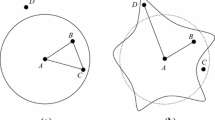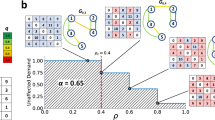Abstract
Many research results in the direction of wireless network capacity are based on the homogeneous Poisson node process and random homogeneous traffic. However, most of the realistic wireless networks are inhomogeneous. And for this kind of networks, this paper gives a constructive capacity lower bound, which may be effective on network designing. To ensure significant inhomogeneities, we select both inhomogeneous node process and traffic. We divide the transmission into two parts: intra-cluster transmission and inter-cluster transmission. Within each distinct cluster, a circular percolation model is proposed and the highway system is established. Different with regular rectangle percolation model, the highway in our model is in the radial direction or around the circle. Based on this model, we propose a routing strategy and get the intra-cluster per-node rate. In the following, among these clusters, we set many “information pipes” connecting them. By getting the results of per-node transmission rate of each part, we can find that the bottleneck of the throughput capacity is caused by the difference of the node density all over the network region. Specially, the lower bound interval of the capacity can be easily obtained when the traffic is inhomogeneous.
Similar content being viewed by others
References
Gupta P., Kumar P. R. (2000) The capacity of wireless networks. IEEE Transactions on Information Theory 46(2): 388–404
Franceschetti M., Dousse O., Tse D. N. C., Thiran P. (2007) Closing the gap in the capacity of random wireless networks via percolation theory. IEEE Transactions on Information Theory 53(3): 1009–1018
Grossglauser M., Tse D. (2002) Mobility increase the capacity of ad hoc wireless networks. IEEE/ACM Transactions on Networking 10(4): 477–486
Gamal, A. E., Mammen, J., Prabhakar, B., & Shah, D. (2004). Throughput-delay trade-off in wireless networks. In 23rd conference of the IEEE computer and communications societies (INFOCOM 2004), Hong Kong, China (pp. 465–476).
Neely M. J., Modiano E. (2005) Capacity and delay tradeoffs for ad hoc mobile networks. IEEE Transactions on Information Theory 51(6): 1917–1937
Ying L., Yang S., Srikant R. (2008) Optimal delay-throughput tradeoffs in mobile ad hoc networks. IEEE Transactions on Information Theory 54(9): 4119–4143
Xie L., Kumar P. R. (2004) A network information theory for wireless communication: Scaling laws and optimal operation. IEEE Transactions on Information Theory 50(5): 748–767
Leveque O., Telatar I. E. (2005) Information-theoretic upper bounds on the capacity of large extended ad hoc wireless networks. IEEE Transactions on Information Theory 51(3): 858–865
Franceschetti M., Migliore M. D., Minero P. (2009) The capacity of wireless networks: Information-theoretic and physical limits. IEEE Transactions on Information Theory 55(8): 3413–3424
Venkatraman H., Kalyampudi P., Muntean G. M. (2012) Cluster-based adaptive scheme for multimedia delivery in heterogeneous wireless networks. Wireless Personal Communications 62(3): 517–536
Toumpis, S. (2004). Capacity bounds for three classes of wireless networks: Asymmetric, cluster, and hybrid. In Proceedings of ACM MobiHoc’ 04, Tokyo, Japan (pp. 133–144).
Kulkarni S. R., Viswanath P. (2004) A deterministic approach to throughput scaling in wireless networks. IEEE Transactions on Information Theory 50(6): 1041–1049
Perevalov E., Blum R. S., Safi D. (2006) Capacity of clustered ad hoc networks: How large is ‘large’?. IEEE Transactions on Communications 54(9): 1672–1681
Alfano G., Garetto M., Leonardi E. (2009) Capacity scaling of wireless networks with inhomogeneous node density: Upper bounds. IEEE Journal on Selected Areas in Communications 27(7): 1147–1157
Alfano G., Garetto M., Leonardi E., Martina V. (2010) Capacity scaling of wireless networks with inhomogeneous node density: Lower bounds. IEEE/ACM Transactions on Networking 18(5): 1624–1636
Garetto M., Nordio A., Chiasserini C., Leonardi E. (2011) Information-theoretic capacity of clustered random networks. IEEE Transactions on Information Theory 57(11): 7578–7596
Moller J. (2003) Shot noise Cox processes. Advances in Applied Probability 35: 614–640
Xue F., Kumar P. R. (2006) Scaling laws for ad hoc wireless networks: An information theoretic approach. Foundations and Trends in Networking 1(2): 145–270
Author information
Authors and Affiliations
Corresponding author
Rights and permissions
About this article
Cite this article
Liu, Z., Yu, L., Gao, Y. et al. A Constructive Capacity Lower Bound of the Inhomogeneous Wireless Networks. Wireless Pers Commun 71, 2333–2348 (2013). https://doi.org/10.1007/s11277-012-0940-8
Published:
Issue Date:
DOI: https://doi.org/10.1007/s11277-012-0940-8




